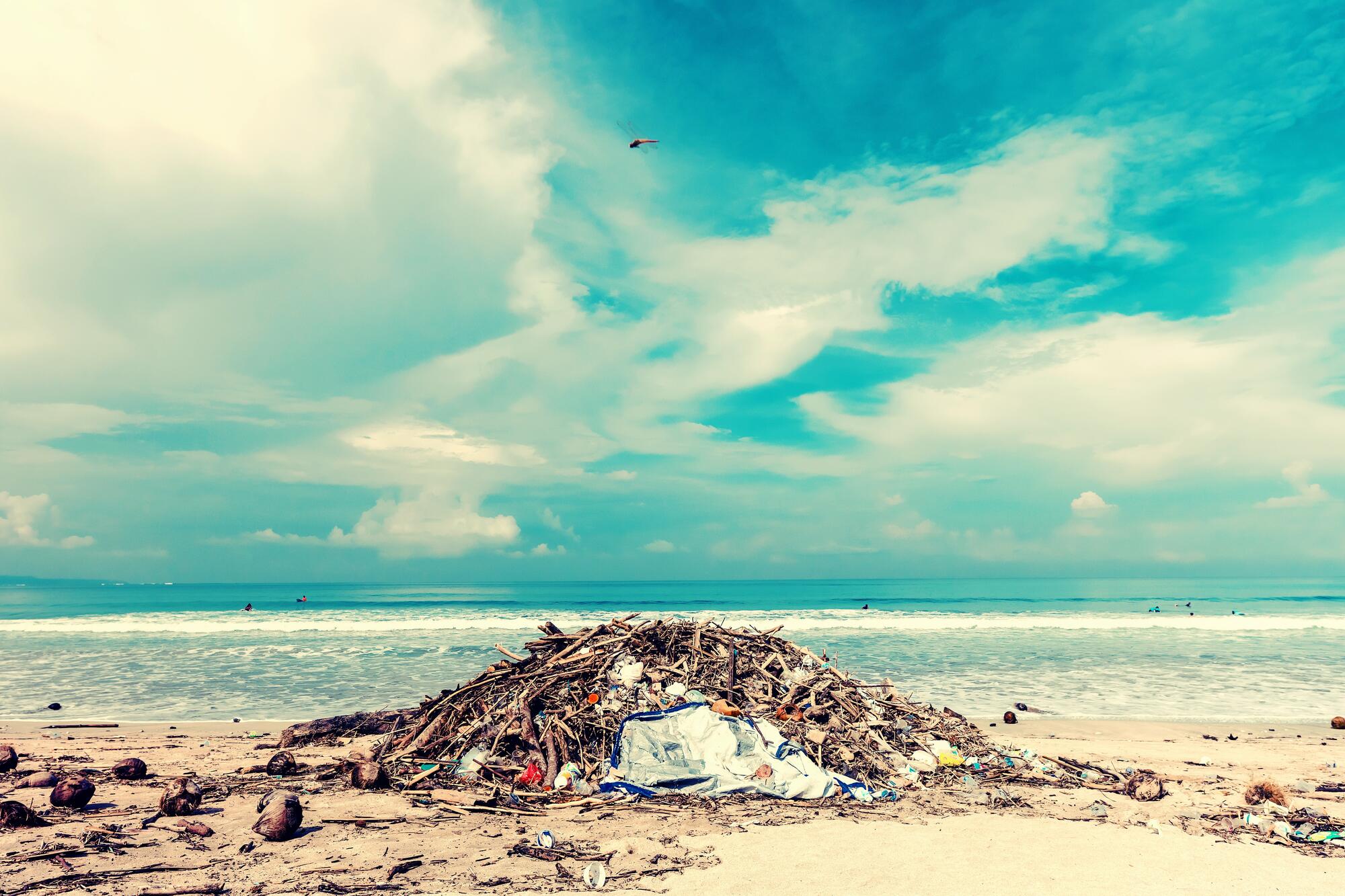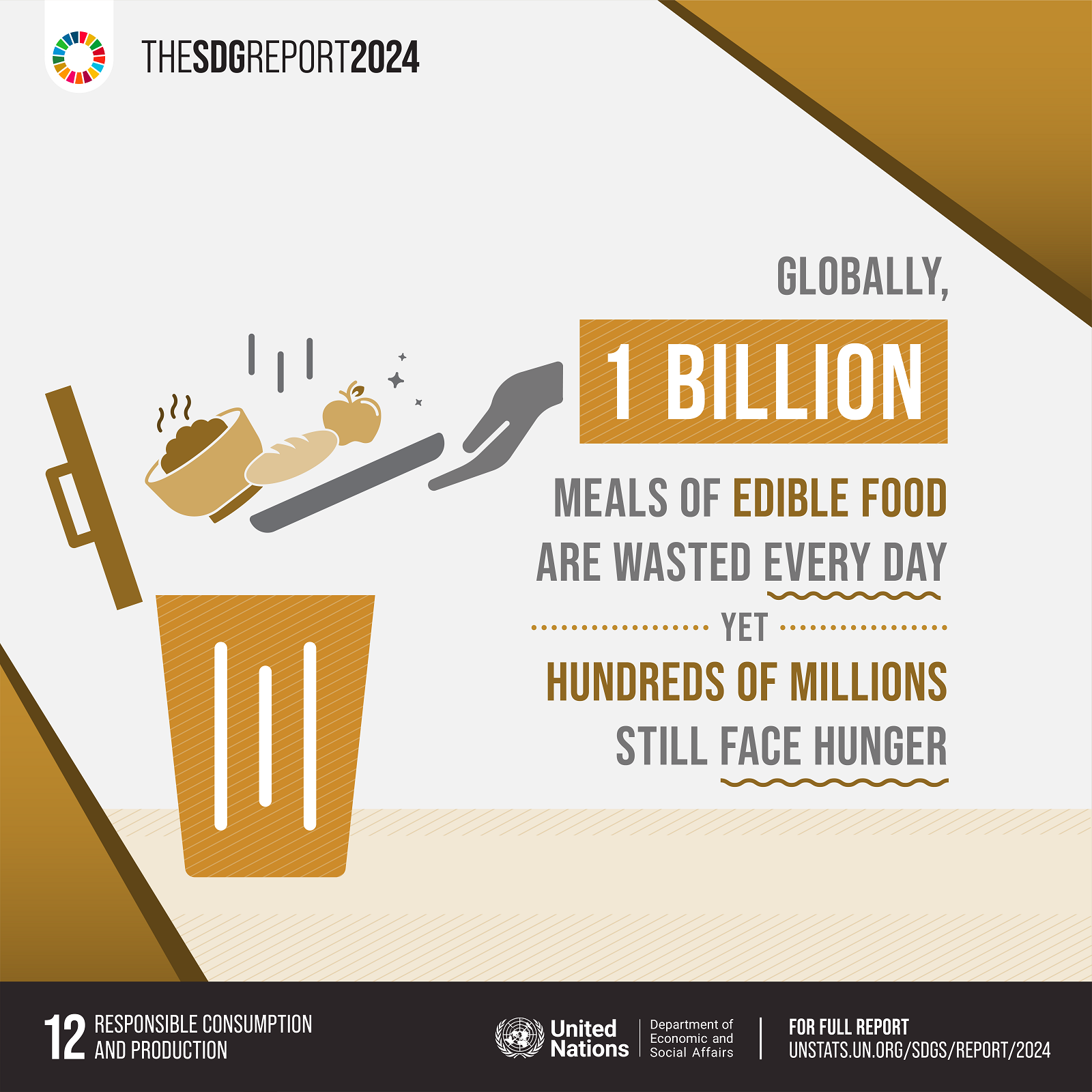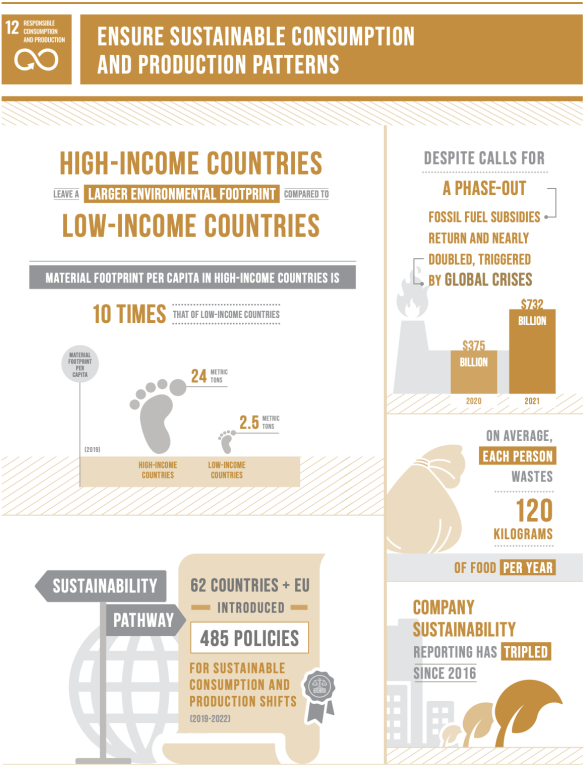
Chemicals and waste

Sustainable consumption and production

Sustainable tourism
Overview
Targets and Indicators

12.1
Implement the 10-Year Framework of Programmes on Sustainable Consumption and Production Patterns, all countries taking action, with developed countries taking the lead, taking into account the development and capabilities of developing countries
12.1.1
Number of countries developing, adopting or implementing policy instruments aimed at supporting the shift to sustainable consumption and production

12.2
By 2030, achieve the sustainable management and efficient use of natural resources
12.2.1
Material footprint, material footprint per capita, and material footprint per GDP
12.2.2
Domestic material consumption, domestic material consumption per capita, and domestic material consumption per GDP

12.3
By 2030, halve per capita global food waste at the retail and consumer levels and reduce food losses along production and supply chains, including post-harvest losses
12.3.1
(a) Food loss index and (b) food waste index

12.4
By 2020, achieve the environmentally sound management of chemicals and all wastes throughout their life cycle, in accordance with agreed international frameworks, and significantly reduce their release to air, water and soil in order to minimize their adverse impacts on human health and the environment
12.4.1
12.4.2
(a) Hazardous waste generated per capita; and (b) proportion of hazardous waste treated, by type of treatment

12.5
By 2030, substantially reduce waste generation through prevention, reduction, recycling and reuse
12.5.1
National recycling rate, tons of material recycled

12.6
Encourage companies, especially large and transnational companies, to adopt sustainable practices and to integrate sustainability information into their reporting cycle
12.6.1

12.7
Promote public procurement practices that are sustainable, in accordance with national policies and priorities
12.7.1
Number of countries implementing sustainable public procurement policies and action plans

12.8
By 2030, ensure that people everywhere have the relevant information and awareness for sustainable development and lifestyles in harmony with nature
12.8.1
Extent to which (i) global citizenship education and (ii) education for sustainable development are mainstreamed in (a) national education policies; (b) curricula; (c) teacher education; and (d) student assessment

12.a
Support developing countries to strengthen their scientific and technological capacity to move towards more sustainable patterns of consumption and production
12.a.1
Installed renewable energy-generating capacity in developing and developed countries (in watts per capita)

12.b
Develop and implement tools to monitor sustainable development impacts for sustainable tourism that creates jobs and promotes local culture and products
12.b.1
Implementation of standard accounting tools to monitor the economic and environmental aspects of tourism sustainability

12.c
Rationalize inefficient fossil-fuel subsidies that encourage wasteful consumption by removing market distortions, in accordance with national circumstances, including by restructuring taxation and phasing out those harmful subsidies, where they exist, to reflect their environmental impacts, taking fully into account the specific needs and conditions of developing countries and minimizing the possible adverse impacts on their development in a manner that protects the poor and the affected communities
12.c.1
Amount of fossil-fuel subsidies (production and consumption) per unit of GDP
Progress and Info
Globally, sustainability efforts are advancing, with an increasing number of policies supporting sustainable consumption and production. Environmental agreement compliance remains strong. However, challenges persist, including low sustainable e-waste management and high fossil fuel subsidies. Corporate sustainability reporting has expanded dramatically, with most large companies now disclosing environmental performance through standardized mechanisms. These trends highlight progress while underscoring the need for continued focus on waste management, energy conservation and emissions reduction. The United Nations is advancing Goal 12 through such initiatives as the 10-Year Framework of Programmes on Sustainable Consumption and Production Patterns, which helps countries to implement sustainable consumption policies and improve waste management.
Target 12.1 - As at 2025, 530 policy instruments related to sustainable consumption and production have been recorded, with 71 countries participating, a 6 per cent increase from the previous reporting cycle.
Targets 8.4 and 12.2 - From 2015 to 2022, global domestic material consumption grew by 23.3 per cent, with per capita domestic material consumption rising to 14.2 tons. Non-metallic minerals led the increase, up 39 per cent, while biomass, metal ores and fossil fuels grew by 11.8 per cent, 7.4 per cent and 6.2 per cent, respectively. Latin America and the Caribbean saw the highest rise, at 132 per cent. Material footprint grew by 21.3 per cent, with persistent regional inequalities.
Target 12.3 - There were 1.05 billion tons of food wasted in 2022, with 60 per cent of waste from households, equating to more than 1 billion meals discarded daily. There are growing global efforts to reduce food waste, with countries such as Japan and the United Kingdom of Great Britain and Northern Ireland cutting waste by 31 per cent and 18 per cent, respectively, showing that large-scale action is possible.
Target 12.5 - In 2022, global e-waste reached a record 7.8 kg per capita, with only 22.3 per cent properly managed, a figure declining since 2010. Significant uncontrolled transboundary movement continues.
Target 12.6 - Sustainability reporting has become standard for large companies, with 96 per cent of the world’s 250 largest companies by revenue and 79 per cent of the top 100 companies in each country surveyed now reporting on sustainability, up from 64 per cent in 2015. Driven by mandatory reporting and international standards, the number of sustainability reports grew fourfold from 2016 to 2023, led by companies in Asia, Europe and North America.
Target 12.c - In 2023, fossil fuel subsidies fell by 34.47 per cent to $1.10 trillion, down from a record $1.68 trillion in 2022, owing mainly to lower energy prices and the end of COVID-19 support measures. However, subsidies are still approximately three times higher than they were before the COVID-19 pandemic, showing no sustained reversal of recent trends.

For more information, please visit: https://unstats.un.org/sdgs/report/2025/
More details on SDG 12 in 2025: https://unstats.un.org/sdgs/report/2025/Goal-12/
The 2025 Extended Report on SDG 12 can be found here: https://unstats.un.org/sdgs/report/2025/extended-report/Extended-Report-2025_Goal-12.pdf









